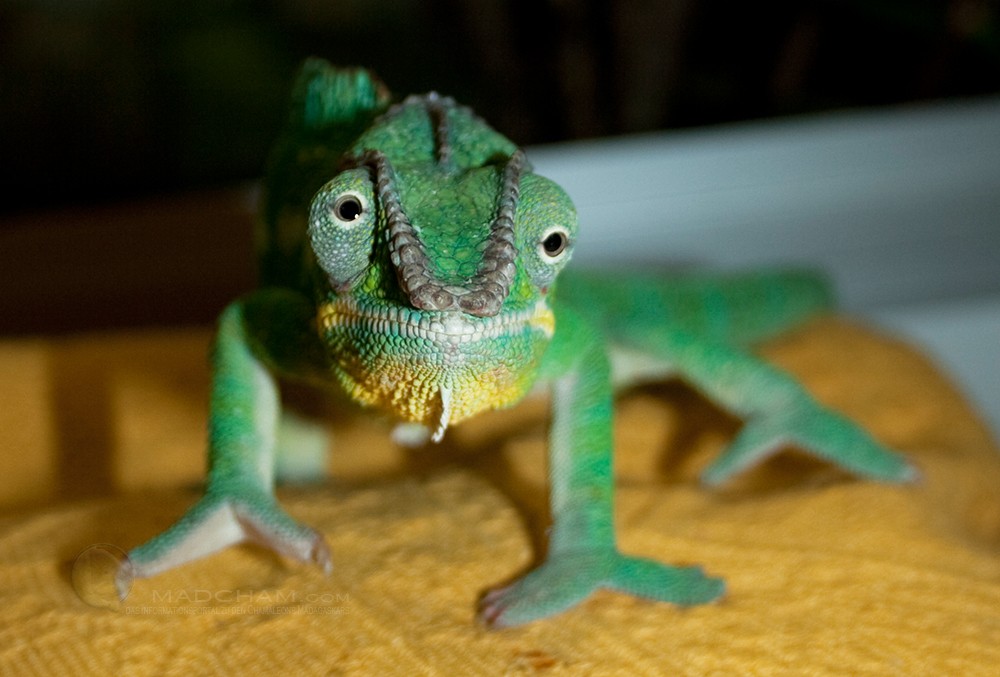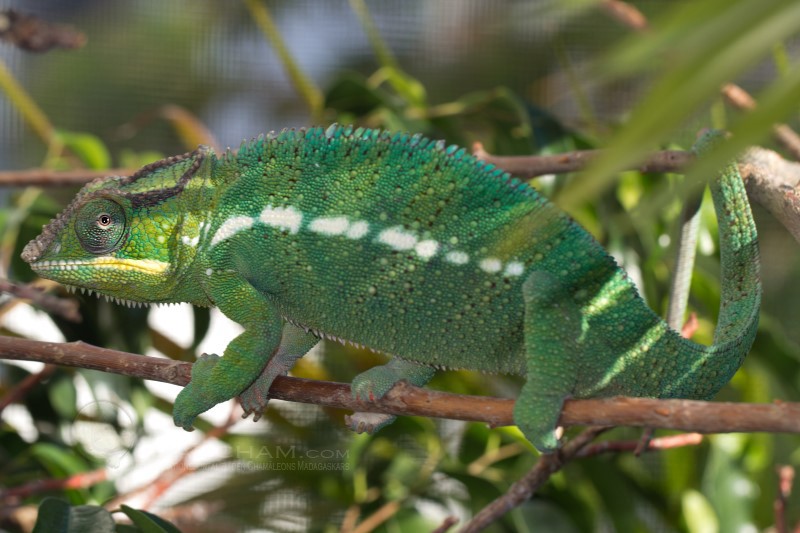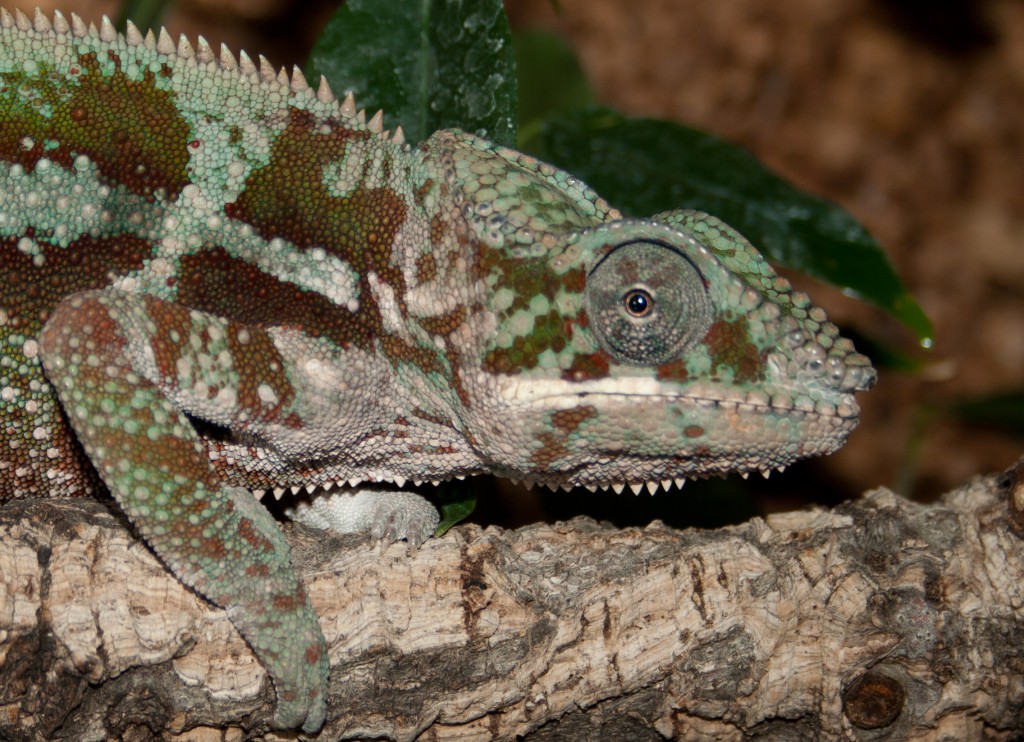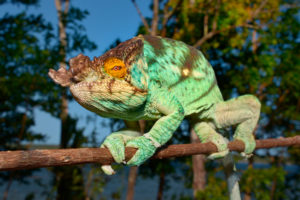Again and again, pictures pop off in the world wide web showing chameleons “free-roaming” inside the living room, optionally in kitchen, sleeping room or at the balcony, too. In most cases, the animals sit on wardrobes, curtain rods, walk over carpets or are carried around by their keeper on arms or sitting on the head. In this article, we have summarized why these “walks” or “free-range” can become a problem for a chameleon and why in our opinion, chameleons should generally stay inside their cages.
The original idea of keeping reptiles in captivity is to have a certain animal in your house or flat, but imitate its natural habitat as close as possible. Climate is among these natural conditions, and thanks to several different types of bulbs, cages, plants and other equipment, it is absolutely no problem to imitate a rainforest or dry forest anymore at home.
But the climate in human households is completely different: A continuous lightning and imitation of natural sunlight are not possible with some single bulbs in the living room (additionally, those bulbs would be reachable for the animals and thus represent an enormous risk of injury). In living rooms, the essential supply with UVB radiation does not work, too. Normal windows do not let UVB through, but chameleons instinctively walk there because it is the brightest place in the room. Normally, the brightest place in the wilderness is the place where is plenty of warmth and UVB. But instead, in human living rooms, the place in front of the window is cold and the air is dry by heating. In a cage, the climate is substantially influenced by living plants. Between the plants, the humidity that is necessary for keeping a chameleon can be reached easily. But living or sleeping rooms, as well as kitchens and other rooms, cannot be planted densely, let alone regularly spraying with water. So a living room has always too low humidity for a chameleon.
Another problem is the temperature of the environment. In a cage, you can create temperatures dropping from top to bottom, having sunny places with warming bulbs and temperatures over 25°C available all day long. An average living room instead has a room temperature of 20 to 22°C. Reptiles are ectotherm, which means their body temperatures depend on their environment. They cannot keep a certain body temperature in a cooler environment like humans, dogs or cats do. Reptiles rely on sunny places, so their whole body and with it all metabolic processes can work.
A chameleon that is exposed to suboptimal environmental conditions again and again (here: temperature, brightness, UVB, air humidity) will develop a weakened immune system on a long-term base. It will be more prone to diseases. Even after years, this “free-range” keeping inside living rooms or on windowsills can still lead to diseases. Sadly, lately recognized pneumonias are quite common among chameleons kept this way.
More reasons that argue against keeping chameleons outside their cages or let them run around in the house:
Chameleons are extremely well climbers and can reach the most impossible locations. Desk lamps, bottles, and other stuff fall over if a chameleon tries to climb up on it. Mostly, the stuff falls down completely including the chameleon. Tilted windows or slammed doors may become sources of danger easily. In worst case, these end deadly for such a relatively small animal like a chameleon. It does not need to be a hot plate or a predator such as a dog or a cat – the average living room already offers plenty of opportunities to injure a chameleon. You can completely avoid all these dangers by keeping your chameleon in a cage.
But chameleons are not only exposed to many sources of danger in rooms, they can also easily “disappear” behind wardrobes, under or even in couches or other allegedly inaccessible places. This may sound strange for a moment, but that is reality. Many chameleon keepers that had their animal running around in living areas already spent hours to find their animal again.
If you keep a chameleon completely or mainly outside a cage, you also take away one of the already limited opportunities for environmental enrichment by feeders. In a cage, the reptile has to hunt for its feeders, but no one wants to have crickets and roaches run around freely in his living room for sure.

“He tries to come out!” – An often completely falsely interpreted behavior.
Often, chameleon keeper say that their animal “wants” to go out, that it even scratches the glass. Usually, this chameleon does not look for “the new habitat living room”, but for the brightest place nearby – often this is a window with direct sun rays coming in. In these cases, the cage has a problem: The lightning might be too dark, there may be too less UVB radiation or temperatures are not adequate. A too small or insufficiently equipped cage can also make a chameleon look for a “better” place. It follows its instincts, but cannot know that a living room is an even less suitable place than its obviously suboptimal cage. This is the point when we as keepers need to improve the cage instead of leaving the chameleon “roam freely” around. By the way, chameleons do not recognize glass walls, because nature has not any. And since they learn slowly, they often try rigidly for a long time again and again to get over the invisible barrier. As a keeper, you can find a remedy by making the cage borders “visible” for your animal. This way the problem is quickly solved. But please keep in mind to think about your cage setup, and optimize it if necessary.
Finally, keeping a reptile in living rooms is also a matter of hygiene. As non-domesticated wild animals, chameleons cannot be trained to use a certain place to defecate. So their droppings fall to the floor, on couches or kitchen tables. This (and only this) is the only disadvantage every keeper has to decide for himself.
The often well-intentioned “free-range” is mostly a bad idea in chameleons. The better choice would be to create a species-appropriate equipped cage that imitates nature as close as possible. “Free-roaming” in rooms is not healthy for a chameleon for sure.
If you want to offer your animal more space or some kind of climbing park, please create a larger cage or transform a complete room (with sealed walls, good plantation, rain systems etc.) into a chameleon cage. In summer, generously spaced outdoor cages are great and let the chameleon enjoy natural sunshine. This is also when the only allegedly advantage of “free-roaming” drops: That the chameleon has a larger radius of movement. Finally, size and equipment of a cage are questions of costs, but please do not try to safe money at the expense of your chameleon.

















